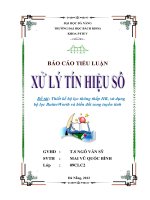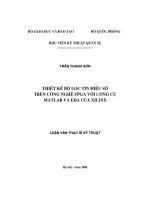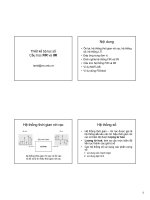Design iir filter on fpga technology combined with matlab simulink software tools and electronic design automation software (thiết kế bộ lọc iir trên công nghệ fpga kết hợp cá
Bạn đang xem bản rút gọn của tài liệu. Xem và tải ngay bản đầy đủ của tài liệu tại đây (647.99 KB, 5 trang )
International Journal of Research In Vocational Studies (IJRVOCAS)
VOL. 1, NO. 4, April 2022, PP. 66~70
Print ISSN 2777-0168| Online ISSN 2777-0141| DOI prefix: 10.53893
/>
Design IIR Filter on FPGA Technology Combined with
Matlab-Simulink Software Tools and Electronic Design
Automation Software
Hong Ngan Vo1, Xuan Toai Nguyen1, Thanh Lanh Le1, Nam Thoi Le1
1Dong
Nai Technology University, Viet Nam
Email address:
; ; ;
To cite this article:
Author’s Name. Paper Title. International
/>
Journal
of
Research
in
Vocational
Studies
(IJRVOCAS),
X(X),
XX–XX.
Received: Dec 08, 2021; Accepted: Dec 16, 2021; Published: Feb 19, 2022
Abstract: This paper presents the design of an IIR filter on FPGA technology by combining modeling with automation of
digital system design, in order to provide a solution to design and quickly implement the digital signal processing system. The
IIR filter is designed by the method of object modeling (Model Based Design) abbreviated as MBD with the help of Matlab and
EDA, then experimentally implemented the IIR filter on FPGA technology for a specific problem and achieved quite good results.
Through this method, it has helped designers reduce design effort and time, improve economic efficiency, and more importantly,
the design is highly flexible, ready to response the new technical requirements of the technology.
Keywords: IIR Filter, EDA, FPGA, Matlab, MBD
1. Introduction
Currently Altera is known for its FPGA, CPLD and ASIC
their software to convert from hard designs into VHDL
architectures that allow programming on it. With a growing
languages applied to FPGA and CPLD technologies including
number of customers, Altera's 2006 sales were 1.29 billion
Matlab, Multiplex sim, Altium Designer, Modelsim, [1-4]
USD. Altera's headquarters is located in San Jonse, California
with a staff of approximately 2,600 employees in companies
in 19 countries.
In the early 2000s, in technical journals, articles about a
new design idea for FPGAs and CPLDs began to appear,
which were later called "Model Based Design" as the article
An FPGA consists of an array of discrete elements that
by Professor: Uwe Meyer_Baese, Ph.D. by the University of
can be interconnected in a common way, and like a PLD, the
Florida or by Stranneby and William Walker. etc. This design
connections between the elements are programmable. That
method brings high economic efficiency. Up to now, almost all
leads designers to write programs in functional blocks.
application designs have followed this method [5-8].
Because of this idea, software vendors have begun to allow
Quartus is Altera's software development tool that
2
provides a comprehensive design environment for SOPC
and after. The IIR filter has low amplitude attenuation, the
(system on a programmable chip) designs [9]. This is a fully
structure is much simpler than the FIR filter.
integrated package software for logic design with Altera's PLD
In this paper, the Chebyshev-type2 IIR filter [15] will be
programmable logic components, including APEX, Cyclone,
designed with the structure shown in Figure 1 with selected
FLEX, MAX, Stratix... Quartus helps designers almost all the
parameters.
most necessary tools to be able to complete a design project in
the fastest and most efficient way. Quartus integrates the most
advanced technologies with flexibility, user-friendly GUI
interface.
During this period, FPGA and CPLD played a very
important role in digital system processing, which was the
basis for digital electronic devices. It has a strong impact on
fields
from
Electronics
and
Telecommunications
to
Information Technology, National Security and Defense, etc.
and it will certainly contribute significantly to the
industrialization and modernization of our country.
This paper presents an IIR filter design with the desire to
provide a product designed on FPGA technology for
Figure 1. Schematic diagram of the Chebyshev-type2 filter
First, we will create a filter block Filter_Cheb2 with the
following input parameters for the filter: multiplier, input and
output data parameters, register structure, and arithmetic
algorithm for the filter.
convenience, with the shortest time and the highest economic
efficiency. A modeled and measured audio noise filter gives
good results.
2. Objects and Methods
We know that the spectrum of human voice has energy
concentrated in the frequency range from 0.8Khz to 1.7Khz to
be able to clearly recognize each person's voice, then the
standard telephone bandwidth is from 0.3Khz to 3.4. Khz.
Suppose for some reason that the audio frequency signal
(human voice) during this recording process is penetrated by
high-frequency noise, reducing the sound quality, causing the
terminal device (of the communication system to) no longer
recognizes the original signal form. And the noise energy is
scattered in the frequency range from 10Khz to 100Khz. The
task is to design a filter to remove the above noise from the
signal source to ensure the best output signal quality.
In order to reduce or enhance a certain frequency range
of the signal, we often use a filter. Digital filtering is classified
into two types FIR (Finite Impulse Response) and IIR (Infinite
Impulse Response) [10-12].
The IIR filter works recursively, using past values of the
output [13-14]. That way, we can implement a filter that needs
only low order but the passband has the same slopes before
Figure 2. Input and output data for the filter and Simulink
simulation block for the filter after creation
3
In Simulink's environment, we set up the simulation
Figure 5. Waveform of the test points in the system.
block as follows: Sin signal and noise generator block, filter
Waveform 1: Sine signal; Waveform 2: Noise signal;
block as well as display block as shown in the following
Waveform 3: Sum of the Sin signal + noise; Waveform 4:
figure:
Sine signal after filter
Thus, we see that the waveform after passing the filter
meets the necessary requirements such as less signal
attenuation, the signal after filtering compared to the signal
before filtering is equivalent. Although the Chebyshev_2 filter
Figure 3. Setting up the simulation system in
Simulink
The specifications of the Sin generator and the noise
generator are shown in the following figure:
is phase-delayed, it is still acceptable.
Looking at the output signal form compared to the input
signal form of the filter, we see that the output signal
completely responses the technical requirements that have
been set out for the filter. Thus, this filter can be introduced to
realize in FPGA.
At this point, you can load it directly on the DE2 board
for testing or use the simulation program available on Quartus
II. Looking at the test results, we can see that the filter can be
realized by the diagram of the FPGA just created. Switching
from the VHDL language to the principle circuit from the
Figure 4. Setting the sine wave and noise block parameters
In the Simulink environment we run the simulation.
Altium Designer Winter 09 software tool, we get the
schematic diagram of the filter principle as follows:
Simulation results are displayed in Scope, the waveform is
shown from the bottom up as follows:
Figure 6. Principle circuit diagram created from Altium
software tool
Below is a block diagram of the process of measuring
and checking IIR filters on FPGA technology. Audio and noise
4
signals are generated at the transmitter. It is then converted to
Figure 9. Generatosaur software interface
a digital signal by an ADC converter. At the output filter_out
Use a circuit to combine 2 signals and noise. Then put
(FPGA) we connect to the DAC converter, the signal after the
it into the 12bit ADC of the dsPIC33FJ128GP802
microcontroller, then output the port to the FPGA, the FPGA
DAC is checked by an oscilloscope.
filters the output signal with the IIR filter designed above, then
give the port of the FPGA. From here, put into another port of
the PIC, use the DAC (16bit) to generate analog signals.
The actual experimental circuit has the following
Figure 7. Digital filter implementation block diagram
parameters: 12-bit ADC with a maximum sampling frequency
of 500Khz equal to 5 times the frequency of the signal. The
3. Results and Discussion
signal wave to be filtered is limited to about 100Khz or less.
The IIR filter on FPGA technology is modeled as shown in
Figure 8. Using the computer output to generate a sine wave
(fluctuates in the range of 100Khz or less), then using
Generatosaur software to generate white noise as shown in
Figure 9. Input selection Output white noise (White noise) is
left (LEFT), output right (RIGHT) is sine wave (Sinus) by
selecting Active frequency f(Hz) change according to
requirements.
The 16-bit output DAC has a maximum output sample rate of
100Khz, just enough for the input 100Khz signal. Mixed
waves with amplitudes from 0 to 3V3.
The signal obtained after passing through the
Chebyshev-type2 IIR filter as shown in Figure 10 has
eliminated noise quite well. However, the signal is not smooth
and has a small bump.
Figure 10. Waveform at filter output
Figure 8. Filter test model
4. Conclusion
An IIR filter design on FPGA technology was modeled
with the help of Matlab and EDA for a specific problem and
achieved quite good results. With the desire to offer a product
designed on FPGA technology so that it is convenient, with
the shortest time and the highest economic efficiency. A
problem of IIR filters in general as well as digital filters in
particular is that the better the quality of the signal filter, the
more signal degradation will be. However, the signal quality
of the digital filter is much better than that of the analog filter.
In order to have good digital filter quality and the least signal
5
loss, we can use an amplifier, in addition, both signal and noise
implementation of FIR and IIR digital filters with
must be accurately determined in terms of amplitude and
variable frequency characteristics." IEEE Transactions
frequency for the signal selection to be effective.
on Circuits and Systems II: Analog and Digital Signal
Processing 49.11 (2002): 689-703.
[13] Yang, Jar-Ferr, and Fu-Kun Chen. "Recursive discrete
Fourier transform with unified IIR filter structures."
References
Signal processing 82.1 (2002): 31-41.
[1] Trimberger, Steven, et al. "A time-multiplexed FPGA."
[14] Montazeri, Allahyar, and Javad Poshtan. "A new
Proceedings. The 5th Annual IEEE Symposium on Field-
adaptive recursive RLS-based fast-array IIR filter for
Programmable Custom Computing Machines Cat. No.
active noise and vibration control systems." Signal
97TB100186). IEEE, 1997.
Processing 91.1 (2011): 98-113.
[2] Obaid, Zeyad Assi, Nasri Sulaiman, and M. N. Hamidon.
"FPGA-based implementation of digital logic design
using Altera DE2 board." International journal of
computer science and network security 9.8 (2009): 186194.
[3] Hachour, Ouarda, and Nikos Mastorakis. "IAV: A VHDL
methodology
for
FPGA implementation."
WSEAS
Transactions on Circuits and Systems 3.5 (2004): 10911096.
[4] Navabi, Zainalabedin. "PLD Based Design." Digital
Design and Implementation with Field Programmable
Devices. Springer, Boston, MA, 2005. 3-16. Wilson,
Peter.
[5] Design recipes for FPGAs: using Verilog and VHDL.
Newnes, 2015.
[6] Paterno, Fabio. Model-based design and evaluation of
interactive applications. Springer Science & Business
Media, 1999.
[7] Franceschini, Gaia, and Sandro Macchietto. "Modelbased design of experiments for parameter precision:
State of the art." Chemical Engineering Science 63.19
(2008): 4846-4872.
[8] Erkkinen, Tom, and Mirko Conrad. "Verification,
validation, and test with model-based design." SAE
Technical Paper 2008-01 (2008): 2709.
[9] Kleitz, William. Digital Electronics with VHDL, Quartus
II Version. Pearson Prentice Hall, 2006.
[10] Litwin, Louis. "FIR and IIR digital filters." IEEE
potentials 19.4 (2000): 28-31.
[11] Rabiner, L. R., et al. "Some comparisons between FIR and
IIR digital filters." Bell System Technical Journal 53.2
(1974): 305-331.
[12] Pun, Carson KS, et al. "On the design and
[15] Filter, Low-Pass. "Analog Filters." Signals and Systems
(2018): 227.









